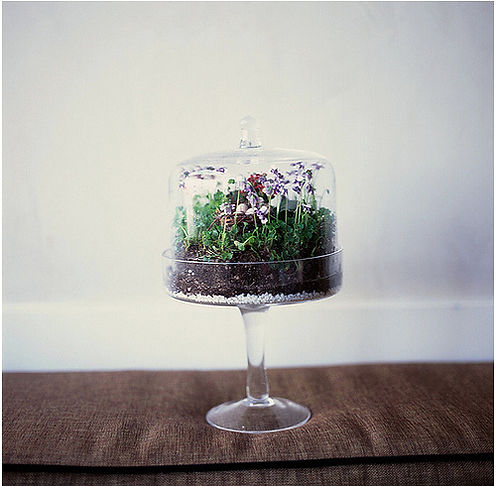History :
The first terrarium was developed by botanist Nathaniel Bagshaw Ward in 1842. Ward had an interest in observing insect behaviour and accidentally left one of the jars unattended. A fern spore in the jar grew, germinated into a plant, and the terrarium was born. The trend quickly spread in the Victorian Era amongst the English. Instead of the terrarium, it was known as the Wardian Case. The story goes that Ward hired carpenters to build his Wardian Cases to export native British plants to Sydney, Australia. After months of travel, the plants arrived well and thriving. Likewise, plants from Australia were sent to London using the same method and Ward received his Australian plants in perfect condition. His experiment indicated that plants can be sealed in glass without ventilation and continue thriving.
Terrariums: are usually sealable glass containers that can be opened for maintenance and to access the plants inside. However, this is not essential; terrariums can also be open to the atmosphere rather than being sealed. Terrariums are often kept as decorative or ornamental items. Closed terrariums create a unique environment for plant growth, as the transparent walls allow for both heat and light to enter the terrarium. The sealed container combined with the heat entering the terrarium allows for the creation of a small scale water cycle. This happens because moisture from both the soil and plants evaporates in the elevated temperatures inside the terrarium. This water vapour then condenses on the walls of the container, and eventually falls back to the plants and soil below. This contributes to creating an ideal environment for growing plants due to the constant supply of water, thereby preventing the plants from becoming over dry. In addition to this, the light that passes through the transparent material of the terrarium allows for the plants within to photosynthesize, an important aspect of plant growth.
A drawing of a Wardian case
Types :
Because of the different conditions within, terrariums can be classified into two types: closed and open.
Closed terrariums :
Tropical plant varieties, such as mosses, orchids, ferns, and air plants, are generally kept within closed terrariums due to the conditions being similar to the humid and sheltered environment of the tropics.
Keeping the terrarium sealed allows for the circulation of water, but terrariums must be opened once a week to remove excess moisture from the air and walls of the container. This is done to prevent growth of mould which could damage the plants and discolour the sides of the terrarium. Terrariums must also be watered occasionally, the absence of condensation on the walls of the terrarium or any wilting of the plants is an indicator that the terrarium requires water.
Closed terrariums also require a special soil mix to ensure both good growing conditions and to reduce the risks of microbial damage. A common medium used is 'peat-lite', a mixture of peat moss, vermiculite, and perlite. The mixture must be sterile in order to avoid introducing potentially harmful microbes.




The Terrarium Guide :

Open terrariums :
Open terrariums are better suited to dry plants such as succulents. Not all plants require or are suited to the moist environment of closed terrariums. For plants adapted to dry climates, open, unsealed terrariums are used to keep the air in the terrarium free from excess moisture. Open terrariums also work well for plants that require more direct sunlight, as closed terrariums can trap too much heat potentially killing any plants inside.
How to set up a terrarium :
First Some Useful videos :
Making New Terrarium & cheap plants
How to Make a Terrarium
DIY Terrarium with Succulents
Easy DIY Glass Terrariums
DIY: Terrariums
DIY Light Bulb Air Plant Terrarium!!
How to make your own terrarium
courtesy to : IKEA
TIME REQUIRED: 1 hour
DIFFICULTY LEVEL: Low
CHILD FRIENDLY FUN: Yes
Spring is here and escaping into the great outdoors is temptingly close. If you can’t wait any longer to get back to nature, then why not bring the outdoors indoors with a homemade terrarium.
These miniature worlds make a conversation-starting centrepiece, and they’re also a great green-fingered project for the whole family.
We love them because they’re easy to make and maintain with very little effort. Don't believe us? In just an hour you can create this succulent terrarium with a few simple ingredients from IKEA.
Read on for our easy terrarium DIY and learn how to make your own today.














Simple Ideas For Adorable DIY Terrariums :
courtesy to : www.buzzfeed.com
For even the most botanically inept, terrariums are super easy to make and incredibly low-maintenance. They also make pretty much the best gifts or party favors ever.
The Basics:
Step 1. Choose an open or closed glass container of some sort.
Step 2. Cover the bottom with an inch-thick layer of pebbles or rocks to create a false drainage system for the plant roots.
Step 3. Add a thin layer of activated charcoal keeps the water fresh, and prevent mold and bacteria from building up.
Step 4. Add a layer of potting soil. They also make a special mix if you choose to use cacti and succulents instead of moss and ferns.
Step 5. Place plants in the terrarium, starting with the largest plant first.


1. Light Bulb Terrarium


2. Magnetic Tin Terrarium






8. Christmas Ornament Terrarium
9. Terrarium Necklace
7. Apple Cider Jug Terrarium
6. Tea Cup Terrarium
5. Succulent Sea-Themed Terrarium
4. Cactus Terrarium
3- Syrup Dispenser and Salt Shaker Terrariums



11. Table Place Holder
10. Pendant Lamps
12. Hanging Terrarium

13- Recycled Soda Bottles

14.Spice Jars



16.Cake Stand Terrarium
15.Fish Bowls
17- Terrarium Kits from Etsy

Select from more than 15 DIY projects..
